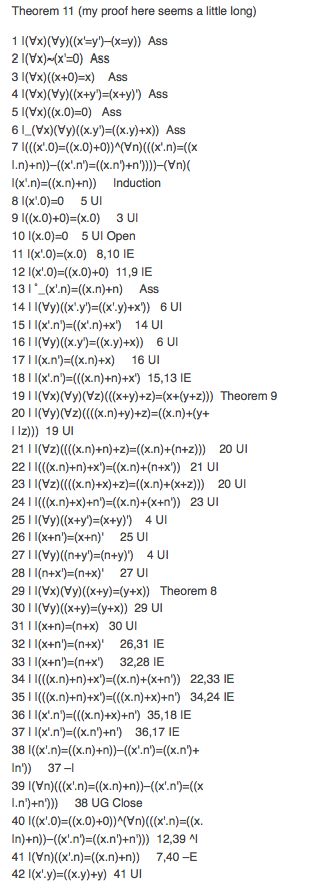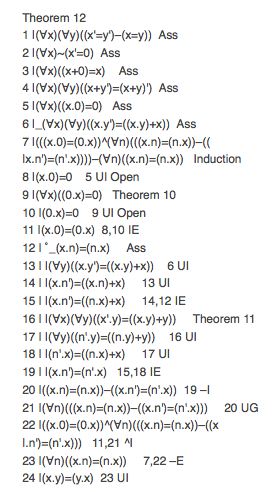12/23/20
Tutorial 5: Number Theory II
Formal Number Theory. Just more theorems for you.
Recall
Formal Number Theory has five proper symbols {=,',+, .,0} and six proper axioms
(∀x)(∀y)(x'=y'⊃x=y),
(∀x)~(x'=0),
(∀x)(x+0=x),
(∀x)(∀y)(x+y'=(x+y)'),
(∀x)(x.0=0),
(∀x)(∀y)(x.y'=x.y+x)
And the axiom (metalanguage) schema of induction. If φ[n] is any formula in the object language with free variable n then
(φ[0]∧(∀n)(φ[n]⊃φ[n'])) ⊃ (∀n)φ[n]
is an axiom. Actually, it is usual to take the closure of this as an axiom (that is, all free variables are quantified over). However, since we have no free variables in the axioms we can form the closure by Universal Generalization, if we want it.
Derive the following theorems (solutions are provided at the end of this Journal)
Exercise to accompany Number Theory II.
exercises under construction 12/14/06
Derive the following theorems (solutions are provided at the end of this Journal)
Exercise 1(of 3)
Derive the following
Theorem 11
(∀x)(∀y)(x'=y'⊃x=y),
(∀x)~(x'=0),
(∀x)(x+0=x),
(∀x)(∀y)(x+y'=(x+y)'),
(∀x)(x.0=0),
(∀x)(∀y)(x.y'=x.y+x)
∴
x'.y=x.y+yTheorem 12
(∀x)(∀y)(x'=y'⊃x=y),
(∀x)~(x'=0),
(∀x)(x+0=x),
(∀x)(∀y)(x+y'=(x+y)'),
(∀x)(x.0=0),
(∀x)(∀y)(x.y'=x.y+x)
∴
x.y=y.xTheorem 13 (distributivity)
(∀x)(∀y)(x'=y'⊃x=y),
(∀x)~(x'=0),
(∀x)(x+0=x),
(∀x)(∀y)(x+y'=(x+y)'),
(∀x)(x.0=0),
(∀x)(∀y)(x.y'=x.y+x)
∴
x.(y+z)=x.y+x.zTheorem 14 (distributivity)
(∀x)(∀y)(x'=y'⊃x=y),
(∀x)~(x'=0),
(∀x)(x+0=x),
(∀x)(∀y)(x+y'=(x+y)'),
(∀x)(x.0=0),
(∀x)(∀y)(x.y'=x.y+x)
∴
(u+v).w=u.w+v.w
Exercise 2(of 3)
Theorem 15 (associativity of .)
(∀x)(∀y)(x'=y'⊃x=y),
(∀x)~(x'=0),
(∀x)(x+0=x),
(∀x)(∀y)(x+y'=(x+y)'),
(∀x)(x.0=0),
(∀x)(∀y)(x.y'=x.y+x)
∴
(u.v).w=u.(v.w)Theorem 16
(∀x)(∀y)(x'=y'⊃x=y),
(∀x)~(x'=0),
(∀x)(x+0=x),
(∀x)(∀y)(x+y'=(x+y)'),
(∀x)(x.0=0),
(∀x)(∀y)(x.y'=x.y+x)
∴
(u+v=w+v)⊃u=wFor the next few theorems we will let 1 be an abbreviation for 0' (we do this by adding 1=0' as an axiom (premise or definition)) and similarly for 2 which abbreviates 0''.
Theorem 17
1=0',
(∀x)(∀y)(x'=y'⊃x=y),
(∀x)~(x'=0),
(∀x)(x+0=x),
(∀x)(∀y)(x+y'=(x+y)'),
(∀x)(x.0=0),
(∀x)(∀y)(x.y'=x.y+x)
∴
u+1=u'Theorem 18
1=0' ,
(∀x)(∀y)(x'=y'⊃x=y),
(∀x)~(x'=0),
(∀x)(x+0=x),
(∀x)(∀y)(x+y'=(x+y)'),
(∀x)(x.0=0),
(∀x)(∀y)(x.y'=x.y+x)
∴
u.1=u
Exercise 3(of 3)
Theorem 19
1=0',
(∀x)(∀y)(x'=y'⊃x=y),
(∀x)~(x'=0),
(∀x)(x+0=x),
(∀x)(∀y)(x+y'=(x+y)'),
(∀x)(x.0=0),
(∀x)(∀y)(x.y'=x.y+x)
∴
u+1=u'Theorem 20
2=0'',
(∀x)(∀y)(x'=y'⊃x=y),
(∀x)~(x'=0),
(∀x)(x+0=x),
(∀x)(∀y)(x+y'=(x+y)'),
(∀x)(x.0=0),
(∀x)(∀y)(x.y'=x.y+x)
∴
2.u=u+u
Solutions
Theorem 11 (my proof here seems a little long)
Theorem 13. This proof is probably long, but it also involves two changes of variables due to wishing to substitute a term like y.n for x in (∀x)(∀y)<something> by UI and, of course, that is forbidden because of capturing. This convinces me that we would do better to state our theorems in terms of variables not quantified in the axioms, u, v, w, say.
If you decide to use the web application for the exercises you can launch it from here Deriver [Gentzen] — username 'logic' password 'logic'. Then either copy and paste the above formulas into the Journal or use the Deriver File Menu to Open Web Page with this address https://softoption.us/test/Deriver/CombinedTutorialsGentzen.html .
Preferences
You will need to set some Preferences for this.
- set identity to true (and that will give you the identity rules)
- set firstOrder to true (to get first order theories)
- and you can check that the parser is set to gentzen.



